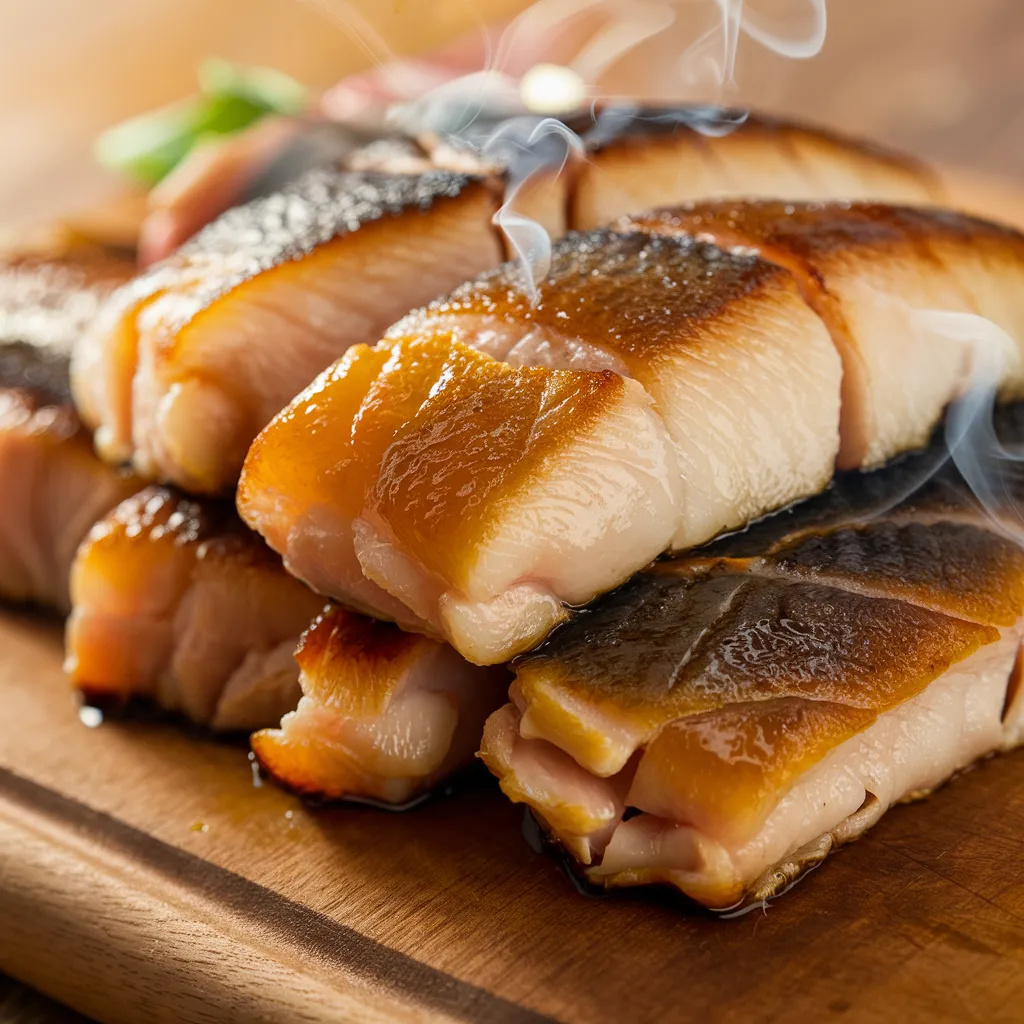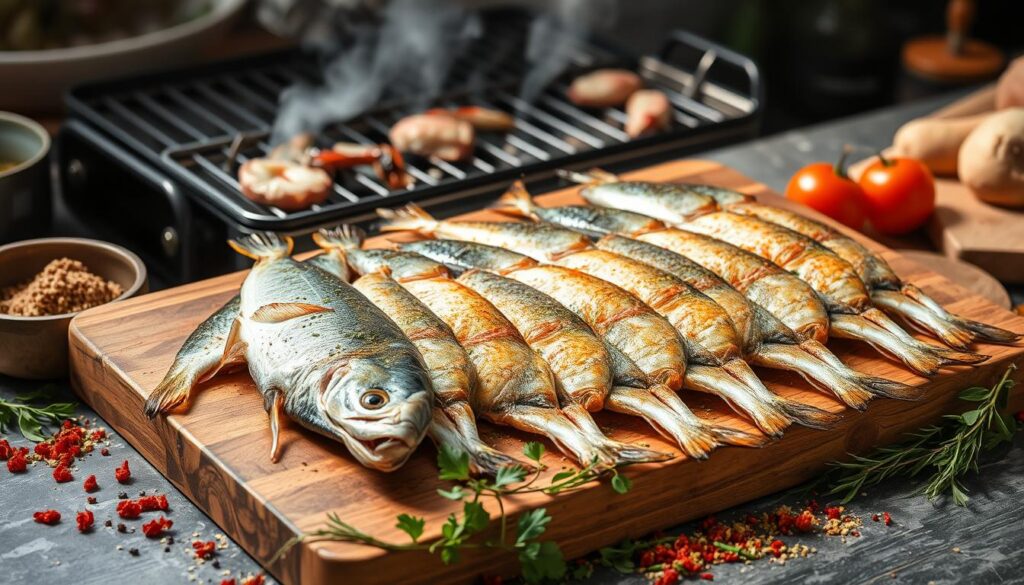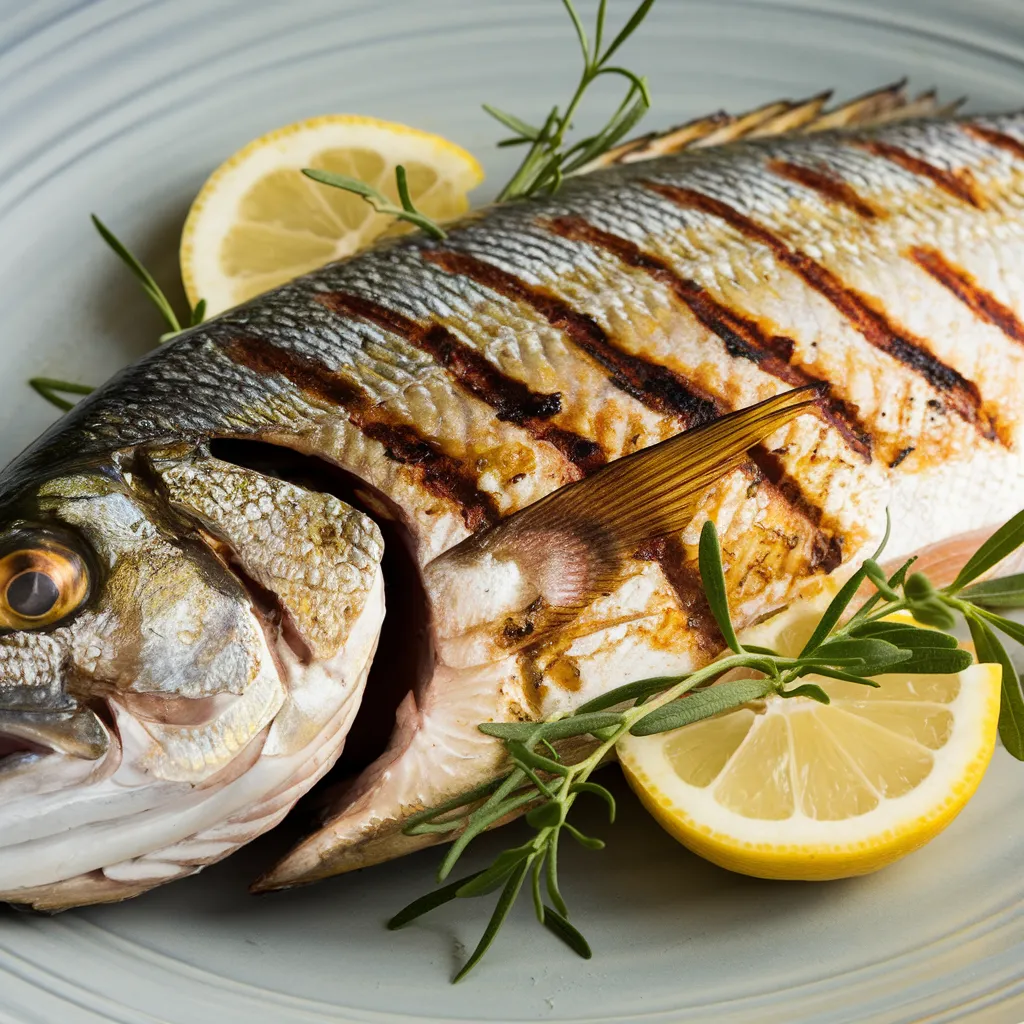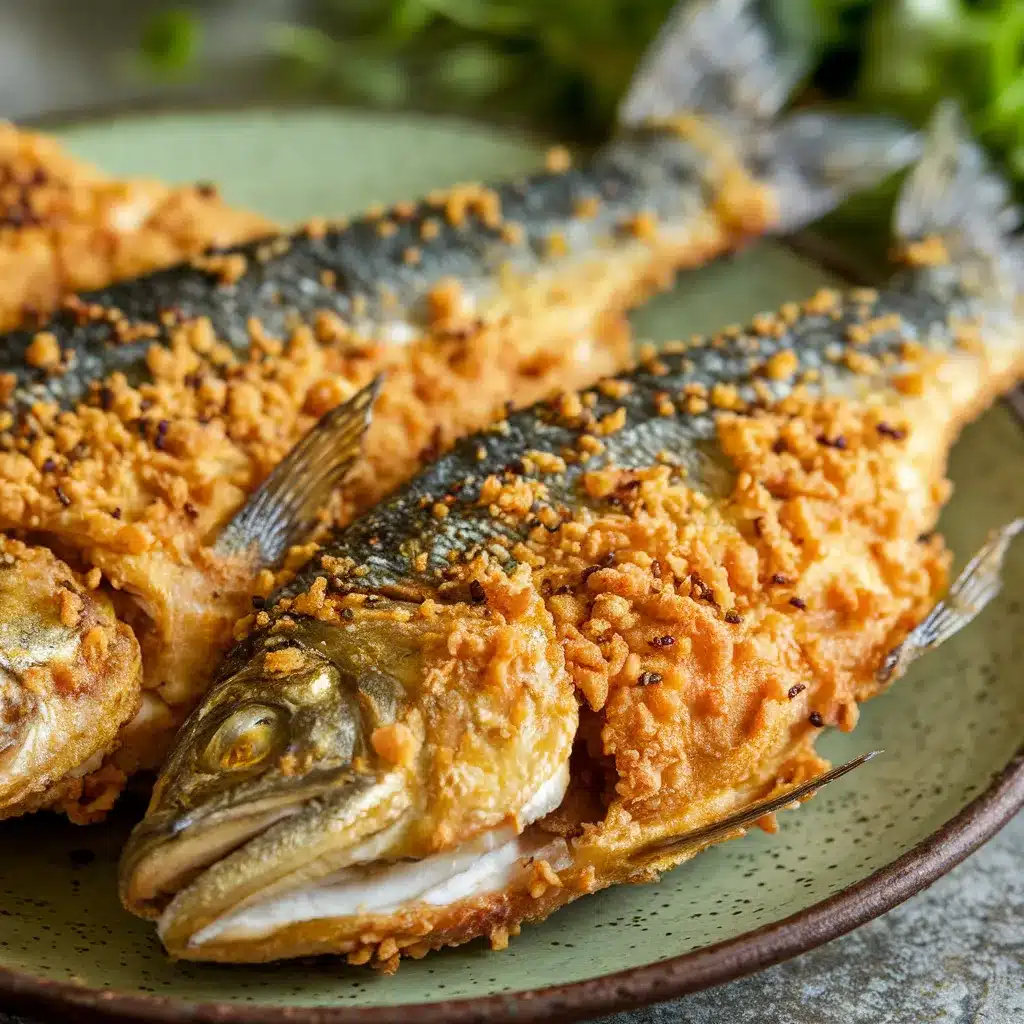Easy Smoked Fish Brine Recipe for Perfect Results

As the sun sets over the hills, the smell of smoked fish fills the air. It brings back memories of time spent by the lake. Whether you love fishing or cooking, smoking fish at home is rewarding. We’ll share how to make a tasty smoked fish brine that turns your catch into a dish to remember.
Picture biting into a smoked fillet that tastes amazing. The flavor is so good, it makes you want more. With the right steps and patience, you can make your favorite fish taste even better. Get ready to improve your home-smoking skills and wow your family with your new talent.
Table of Contents
Understanding the Art of Fish Brining and Smoking
Smoking fish is a mix of science and skill. The brining step is key to turning regular fish into delicious, smoky treats. Let’s explore the science of brining and the hot and cold smoking methods.
The Science Behind Fish Brining
Brining makes smoked fish taste great and feel right. Fish soaks in a mix of water, salt, and sometimes sugar or spices. This makes the fish taste better and feel firmer, ready for smoking.
The salt pulls moisture out of the fish, while sugar adds sweetness. It also helps create a pellicle, a shiny surface for smoke to stick to. This mix of ingredients makes the fish perfect for smoking.
Hot Smoking vs. Cold Smoking Methods
There are two main ways to smoke fish: hot and cold smoking. Hot smoking uses a quick brine and cooks the fish at 225°F. It gives a strong smoky taste and a firm texture.
Cold smoking takes longer, with a day-long brine and smoking at 90°F for 12 hours or more. It makes the fish taste milder and feel softer.
Why Brining is Essential for Smoked Fish
Brining is crucial for smoked fish. It stops bad bacteria from growing, keeping the fish safe and fresh. The salt in the brine makes it hard for these bacteria to survive.
Brining also brings out the fish’s natural flavors and adds extra seasonings. These flavors mix well with the smoky taste from smoking. This creates a rich, enjoyable taste experience.
Learning about brining and smoking will help you make perfectly smoked fish. Your friends and family will be amazed.
Best Types of Fish for Smoking
Choosing the right fish for smoked fish recipes is key. Look for fish with firm flesh that can handle the smoking process. Fish with more oil content usually taste richer and more flavorful.
Some top picks for best fish for smoking are:
- Salmon – Farm-raised Atlantic salmon and wild king salmon (Chinook) are excellent choices due to their high fat content. Wild sockeye salmon is a leaner alternative that still holds up well to smoking.
- Trout – Trout has a delicate, slightly sweet flavor that pairs beautifully with the smoky notes of the cooking process.
- Bass – Both freshwater and saltwater bass varieties, such as largemouth bass and striped bass, make fantastic smoked fish.
- Catfish – Catfish has a mild, slightly sweet flavor that takes well to smoking. It’s important to brine catfish before smoking to prevent it from drying out.
- Paddlefish – Also known as spoonbill, paddlefish has a firm, meaty texture that stands up to smoking.
When picking fish, aim for fillets that are 1 to 1 1/2 inches thick. This thickness ensures even cooking and allows the fish to fully absorb the smoky flavors. With the right fish selection and smoking techniques, you can create delicious smoked fish recipes that will impress your family and friends.
Essential Equipment and Tools for Fish Smoking
To make delicious smoked fish, you need more than a good recipe. You also need the right tools and equipment. This includes the smoker, temperature control devices, and other accessories. Having the right setup is key for fish smoking techniques and making great smoked fish equipment.
Smoker Types and Features
The heart of fish smoking is a good smoker. You can choose from electric, charcoal, or propane smokers. Each has its own features and benefits. Look for a smoker that controls temperature well, holds enough fish, and smokes consistently.
Temperature Control Tools
Keeping the right smoking temperature is crucial for moist, tasty fish. Get high-quality thermometers and probes. They help you check the smoker and fish temperatures. Digital thermometers are especially good for checking fish doneness.
Additional Smoking Accessories
- Cooling rack: A sturdy cooling rack helps you transfer the smoked fish from the smoker to a safe resting spot.
- Rimmed baking sheet: A rimmed baking sheet provides a convenient surface for brining, drying, and seasoning the fish before smoking.
- Basting brush: Use a basting brush to apply honey, maple syrup, or other flavorful glazes to the fish during the smoking process.
With the right fish smoking techniques and smoked fish equipment, you’ll make perfectly smoked fish every time.
Perfect Smoked Fish Brine Recipe
Creating the perfect smoked fish begins with a great brine recipe. This brine adds the right mix of sweetness and saltiness. It makes your fish both delicious and tender.
The secret to this smoked fish brine recipe is the right mix of ingredients. Start with 4 cups of cool water. Add 1/3 cup of Diamond Crystal Kosher Salt and 3/4 cup of brown sugar. For a dry brine, mix 4 parts dark brown sugar with 1 part kosher salt. Don’t use regular iodized table salt, as it can ruin the taste.
The brown sugar in the brine ingredients adds a sweet touch. It enhances the fish’s natural flavors, making the taste balanced. The kosher salt seasons the fish and makes it firmer and more flavorful.
- Mix the 4 cups of cool water, 1/3 cup of Diamond Crystal Kosher Salt, and 3/4 cup of brown sugar in a non-reactive container until the salt and sugar have fully dissolved.
- Submerge your fish fillets or whole fish in the brine, ensuring they are completely covered. Cover the container and refrigerate for the recommended brining time, which can range from 2 to 12 hours depending on the thickness of the fish.
- Once the brining process is complete, remove the fish from the brine, rinse it under cold water, and pat it dry with paper towels. The fish is now ready for the next step in the smoking process.
The smoked fish brine recipe is just the start of making perfect smoked fish. By using this brine, you’re on your way to delicious results every time.
Dry Brine vs. Wet Brine: Making the Right Choice
Choosing the right brine for smoked fish is crucial. Both dry and wet brining offer unique benefits. Understanding these can help you get the perfect texture and flavor. Let’s explore the advantages of each method for your next brine curing guide or fish brining tips.
Benefits of Dry Brining
Dry brining is quicker and easier. Just sprinkle a small amount of salt on the fish, about a teaspoon for a small fillet. This method draws out moisture and enhances flavor. It also allows for even seasoning.
Advantages of Wet Brining
Wet brining, on the other hand, involves soaking the fish in saltwater. This method spreads the seasoning evenly, adding more flavor. It also makes the fish moist, thanks to the fat solidifying.
Chef Jason Brown says wet brining salmon can be effective in just 15 minutes. Both dry and wet brining can achieve similar textures. Your choice depends on what you prefer. Dry brining is quicker, while wet brining offers more even flavor. Try both to see which works best for you.
Key Ingredients for a Successful Brine
Making the perfect smoked fish brine is about finding the right mix. You need kosher salt, brown sugar, and water. These ingredients bring out the fish’s natural taste, making it smoky and delicious.
Kosher salt is key because it pulls out moisture from the fish. This makes the flavor stronger and more even. Brown sugar adds a touch of sweetness, balancing the saltiness. Water mixes everything together, creating a balanced brine.
Feel free to add herbs, spices, or citrus zest for extra flavor. These can make your smoked fish even more special. Just remember, keep the balance of brine ingredients right to get the best taste.
| Ingredient | Purpose |
|---|---|
| Kosher Salt | Draws out moisture, seasons the fish evenly |
| Brown Sugar | Adds a subtle sweetness to balance the salty, smoky notes |
| Water | Forms the base for the brine solution |
| Herbs, Spices, Citrus Zest | Optional flavorings to create unique smoked fish flavors |

“The ideal concentration of Smoked Salmon Brine typically balances salt and sugar for optimal flavor absorption, often using a ratio of 1:1 salt to sugar.”
Step-by-Step Brining Process
Brining is key in smoking fish. It boosts flavor, texture, and moisture. Follow these easy steps for a great brine:
Preparing the Fish
Rinse your fish under cool water and dry it with paper towels. This makes the brine soak in better.
Applying the Brine
- For wet brining, soak the fish in a brine mix. Use 3 cups of cold water and 5 tablespoons of kosher salt.
- Soak the fish for the right time, based on the fish type:
- Trout, shrimp, sardines: 15 minutes
- Bass, barramundi, sablefish: 20 minutes
- Halibut, mahimahi, bluefish: 30 minutes
- Salmon, mackerel, Arctic char: 35 minutes
- Amberjack, cobia, swordfish: 40 minutes
For dry brining, use a salt-sugar mix on the fish. Refrigerate for 5 hours.
Optimal Brining Times
Brine salmon fillets for 15 to 30 minutes, depending on thickness. Wet-brining is best for salmon to keep it moist.
Rinse the fish under cool water and dry it. Let it dry in the fridge, uncovered, for at least 4 hours. This forms a pellicle, helping smoke stick to the fish.
By following these brining process and fish brining tips, you’ll make delicious smoked fish.
Creating the Perfect Pellicle
When it comes to fish smoking techniques, making a perfect pellicle is key. The pellicle is a sticky, dried layer that forms on the fish in the fridge. It’s vital for the smoked fish preparation process.
The pellicle does two important things. It makes the smoke stick to the fish, improving its taste and look. It also stops a white, creamy stuff from forming on the fish during smoking.
To make the perfect pellicle, just follow these steps:
- Thoroughly pat the fish fillets dry with paper towels, ensuring they are completely dry on the surface.
- Place the fillets on a wire rack or baking sheet, making sure they are not touching each other.
- Refrigerate the fish, uncovered, for at least 4 hours or overnight. This allows the moisture to evaporate, forming the essential pellicle.
Patience is the key to a great pellicle. Letting the fish dry in the fridge will give you a tacky surface. This surface will soak up smoky flavors during smoking.
Remember, the pellicle is a crucial step in the smoked fish preparation process. Don’t skip it. Take the time to dry your fish well. This will help you make a perfectly smoked, flavorful final product.
Wood Selection and Smoking Techniques
Choosing the right wood for fish smoking is key to the flavor. Alder, hickory, apple, cherry, and oak are popular picks. Mesquite adds a strong, unique taste that some love. Try different woods to find your favorite and make unique smoked fish flavors.
To smoke fish, add wood chips to your smoker before putting in the fish. This lets the smoke fully infuse the fish. Also, brush the fish with olive oil to stop it from sticking to the rack.
- Alder wood: Offers a mild, sweet flavor that complements salmon, trout, and other delicate fish.
- Hickory wood: Provides a strong, bold flavor that pairs well with heartier fish like tuna or swordfish.
- Apple wood: Imparts a subtle, fruity essence that enhances the natural sweetness of fish.
- Cherry wood: Lends a delicate, slightly fruity taste that works well with a variety of fish species.
- Oak wood: Delivers a medium-intensity, woodsy flavor that can elevate the taste of many fish types.
- Mesquite wood: Offers a robust, slightly peppery flavor that may overpower more delicate fish.
Try mixing different woods and smoking methods to find your perfect flavor. By exploring wood selection and smoking techniques, you can discover a wide range of smoked fish flavors. This will take your fish smoking to the next level.
Temperature Control and Cooking Times
To get perfect smoked fish, you need to control the temperature well. Start by heating your smoker to 150°F for the first hour. Then, raise it to 180°F for the next 2-3 hours. This slow rise in temperature makes the fish taste great without getting too dry.
For most fish, smoking takes 3 to 4 hours. But, it’s key to check the fish’s internal temperature. It’s done when it hits 140°F. For wild salmon, aim for 130°F to keep it moist.
Optimal Smoking Temperatures
- Start by preheating the smoker to 150°F for the first hour
- After the initial hour, increase the temperature to 180°F for the remaining 2-3 hours
- This gradual temperature rise helps develop a rich, smoky flavor in the fish
How to Know When Fish is Done
- Use a digital meat thermometer to monitor the internal temperature of the fish
- The fish is ready when it reaches an internal temperature of 140°F
- For wild salmon, you may want to cook it to a slightly lower temperature of 130°F to prevent drying
By controlling temperature and cooking time, you can make delicious smoked fish. It will be tender and flavorful, impressing everyone. Don’t forget to brush the fish with honey or maple syrup every 45 minutes after the first hour for extra sweetness.
| Metric | Value |
|---|---|
| Salmon Fillet Weight | 700g |
| Curing and Chilling Time | 24 hours |
| Prep Time | 10 minutes |
| Hands-on Time | 15 minutes |
| Grilling Time | 30-40 minutes |
| Curing Time | Minimum 8 hours |
| Wood Chips Soak Time | Minimum 1 hour |
| Air-drying Time | Minimum 4 hours |
| Smoking Temperature | 200°F (100°C) |
| Internal Temperature | 130°F (54°C) |
| Servings | 4 |
| Nutritional Info per Serving | 285 calories, 1g carbs, 35g protein, 15g fat, 96mg cholesterol, 1847mg sodium |

“Smoking fish is an art that requires patience and attention to detail, but the results are well worth the effort. With the right techniques and temperature control, you can create a mouthwatering smoked fish that will leave your guests wanting more.”
Storage and Preservation Methods
Keeping your smoked fish fresh is key to enjoying its taste. Whether you’re new to smoking or experienced, knowing how to store it right is important.
Refrigerating Smoked Fish
To store it short-term, wrap your smoked fish in plastic wrap or foil. Then, put it in a sealed container or bag. This way, your smoked fish stays fresh in the fridge for up to 7 days.
Freezing Smoked Fish
For longer storage, freeze your smoked fish. Vacuum-seal it and keep it in the freezer for up to 3 months. Some say you can freeze it for a year, but the quality might drop after 3 months.
| Storage Method | Maximum Shelf Life |
|---|---|
| Refrigerator | Up to 7 days |
| Freezer (Vacuum-sealed) | Up to 3 months |
Good smoked fish preservation and smoked fish storage are crucial. They help you enjoy your smoked fish longer. By following these tips, your fish will stay tasty and fresh for a while.
Common Mistakes to Avoid
Smoking fish can be a fun and rewarding experience. But, it’s important to avoid common mistakes that can spoil your effort. By steering clear of these errors, you can ensure your smoked fish is perfect every time.
First, avoid using regular iodized salt in your brine. Choose a non-iodized salt instead. Iodine in regular salt can give your fish a bad taste. Also, don’t make the smoking temperature too high. This can make the fish “bleed” a white substance, ruining the taste.
Creating a good pellicle is key. This sticky layer on the fish’s surface helps prevent the white bleeding. Make sure the pellicle forms well before smoking. Lastly, don’t overcook the fish. Overcooking makes it dry and tough. Check the fish’s internal temperature and take it out when it’s just right.
Another mistake is freezing smoked fish for longer than 3 months. Freezing can keep your fish fresh, but too long can affect its taste and texture. Keep an eye on how long you store it to keep it delicious.
Avoiding these mistakes will help you make perfectly smoked fish. It will impress everyone. Remember, patience, attention to detail, and practice are essential. They will help you master fish smoking techniques and get smoked fish tips that are amazing.
Conclusion
Smoking fish at home is a rewarding experience. You can make smoked fish as good as any restaurant’s. Try smoked trout or bluefish for unique flavors.
Play with different fish, wood chips, and flavors to make your own dishes. Enjoy it on its own, in salads, or in sandwiches. With practice, you’ll impress everyone with your smoked fish.
The secret to great smoked fish is in the details. Follow this guide for the best results. Your smoked fish will be delicious and beautiful. Enjoy the journey and let your creativity shine in every bite.
FAQ
What is the best type of fish for smoking?
Fish like salmon, trout, bass, catfish, and paddlefish work well for smoking. They have firm flesh that holds up well. Salmon, especially farm-raised and wild king salmon, adds rich flavor. Wild sockeye salmon is leaner but still smokes well.
What equipment is needed for smoking fish?
You need a good smoker for hot smoking fish. Use wood chips like alder, hickory, apple, cherry, and oak. Tools for controlling temperature are key. You might also need a cooling rack, baking sheet, and basting brush.
What is the difference between wet brining and dry brining?
Both methods make the fish tender. Dry brining is quicker and easier, needing no water. It uses salt and sugar for flavor. Dry brining for 5 hours is best.
Wet brining involves soaking the fish in brine for 8 to 12 hours. It’s a bit longer but also effective.
What is the purpose of the pellicle in smoked fish?
The pellicle is a sticky layer that forms on the fish. It helps the smoke stick to the fish. This prevents a white, creamy substance from forming.
Let the fish dry in the fridge for at least 4 hours or overnight. This helps create the pellicle.
How long can smoked fish be stored?
Wrap smoked fish tightly in plastic or foil and store in an airtight container. Keep it in the fridge for up to 7 days. For longer storage, vacuum seal and freeze for up to 3 months.
Freezing for more than 3 months can reduce quality. Some say up to a year, but quality drops after 3 months.
What are some common mistakes to avoid when smoking fish?
Don’t use regular iodized salt in the brine. It can affect the flavor. Avoid setting the temperature too high, as it can make the fish “bleed” a white substance.
Make sure the pellicle forms properly. Don’t overcook the fish, as it can become dry. Freeze smoked fish for no more than 3 months to keep it fresh.






